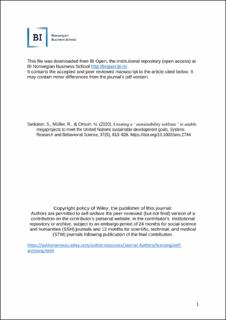Creating a ‘ sustainability sublime ’ to enable megaprojects to meet the United Nations sustainable development goals
Journal article, Peer reviewed
Accepted version
Permanent lenke
https://hdl.handle.net/11250/2978831Utgivelsesdato
2020Metadata
Vis full innførselSamlinger
- Scientific articles [2181]
Originalversjon
Systems research and behavioral science. 2020, 37 (5), 813-826. doi.org/10.1002/sres.2744Sammendrag
Despite cost and schedule overruns and benefits shortfalls, megaprojects (which are large-scale projects that typically cost over a billion dollars and take years to develop and build) continue to be promoted and built creating a megaproject paradox. Prominent megaproject scholar Bent Flyvbjerg (2014) argued that this could be motivated by four ‘sublimes’—technological, political, economic and aesthetic that drive new megaprojects being put forward despite their poor performance. Recent evidence shows that better governance practices are helping to improve the overall performance of megaprojects. Despite the United Nations setting 17 sustainable development goals (SDGs) to be achieved by 2030, there are severe shortfalls in initiatives from governments, public organizations and private businesses endangering the achievement of targets set for these goals. In addition, time is running out to achieve these goals with only a decade left. The current initiatives contributing to these goals appear to be focused on individual SDGs even though many of these are interrelated. This article proposes that if politicians, engineers and scientists, businesses leaders and design thinkers could be motivated by a ‘sustainability sublime’ to create megaprojects that contribute to SDGs, it could benefit both the society and the planet. It also argues that a more integrated view of UN SDGs and a suitable governance structure should be applied to ensure that megaprojects created as a result of the sustainability sublime deliver benefits towards achieving UN SDGs.
